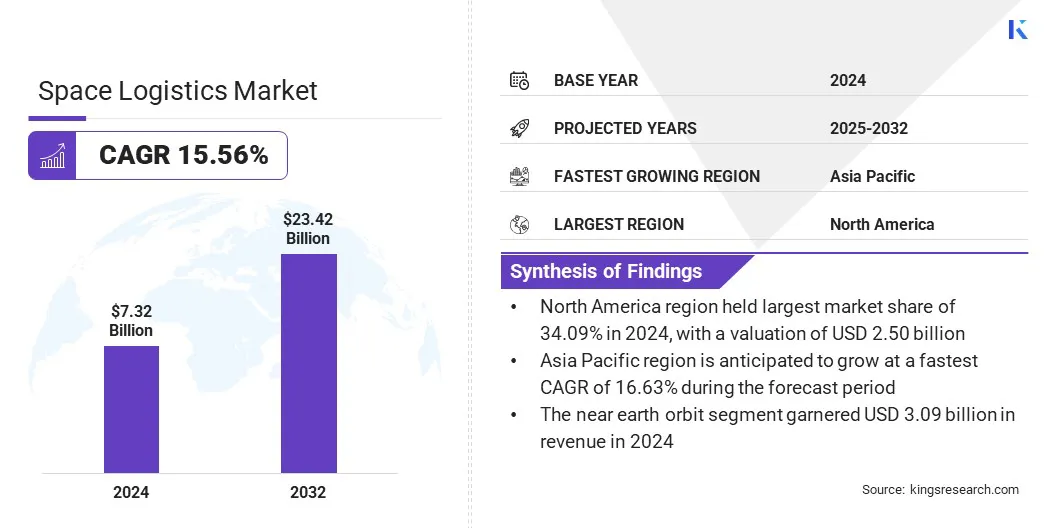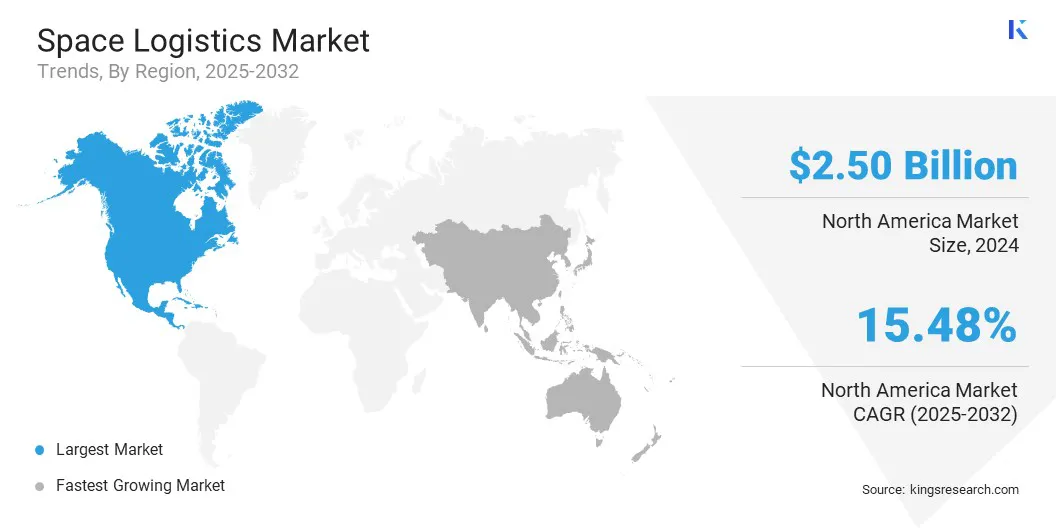buyNow
Space Logistics Market
Space Logistics Market Size, Share, Growth & Industry Analysis, By Type (Mission Extension Pods (MEPs), Cargo Modules, Service Modules, Robotic Arms & Manipulators, Space Tugs), By Operation, By Orbit, By End Use, and Regional Analysis, 2025-2032
pages: 200 | baseYear: 2024 | release: July 2025 | author: Versha V.
Market Definition
Space logistics encompasses the technologies, systems, and services that enable the transportation, servicing, repositioning, and assembly of space assets such as satellites, space stations, scientific payloads, and future infrastructure. It enables mission operations across multiple stages, including launch support, in-orbit delivery, maintenance, life-extension, debris removal, and construction, critical for sustaining long-duration missions and enhancing space-based capabilities.
The global space logistics market size was valued at USD 7.32 billion in 2024 and is projected to grow from USD 8.43 billion in 2025 to USD 23.42 billion by 2032, exhibiting a CAGR of 15.56% during the forecast period.
Market growth is fueled by the growing demand for commercial space cargo return services, as more missions require retrieval of scientific payloads, equipment, and manufactured materials from orbit. The market is witnessing a shift toward end-to-end logistics solutions, with providers offering integrated services across launch, in-orbit servicing, and cargo return to meet evolving customer requirements.
Key Highlights:
- The space logistics industry size was recorded at USD 7.32 billion in 2024.
- The market is projected to grow at a CAGR of 15.56% from 2025 to 2032.
- North America held a share of 34.09% in 2024, valued at USD 2.50 billion.
- The mission extension pods (MEPs) segment garnered USD 2.06 billion in revenue in 2024.
- The last mile delivery segment is expected to reach USD 5.84 billion by 2032.
- The near earth orbit segment is projected to generate a revenue of USD 9.77 billion by 2032.
- The government and defense segment is expected to reach USD 13.81 billion by 2032.
- Asia Pacific is anticipated to grow at a CAGR of 16.63% over the forecast period.
Major companies operating in the space logistics market are ARGO SPACE CORP, ClearSpace, VOYAGER, Blue Origin, Apex, Exotrail, Impulse Space, Inc., D-Orbit, Axiom Space, Inc., Momentus Inc., Astrobotic Technology, Starfish Space, Redwire Corporation, Astroscale, and Orbit Fab, Inc.

Space Logistics Market Report Scope
|
Segmentation |
Details |
|
By Type |
Mission Extension Pods (MEPs), Cargo Modules, Service Modules, Robotic Arms & Manipulators, Space Tugs |
|
By Operation |
Last Mile Delivery, Space Situational Awareness, Life-extension, Active Debris Removal, On-orbit Assembly and Manufacturing, Others |
|
By Orbit |
Near Earth Orbit, Lower Earth Orbit, Geostationary Orbit |
|
By End Use |
Government and Defense, Commercial |
|
By Region |
North America: U.S., Canada, Mexico |
|
Europe: France, UK, Spain, Germany, Italy, Russia, Rest of Europe | |
|
Asia-Pacific: China, Japan, India, Australia, ASEAN, South Korea, Rest of Asia-Pacific | |
|
Middle East & Africa: Turkey, U.A.E., Saudi Arabia, South Africa, Rest of Middle East & Africa | |
|
South America: Brazil, Argentina, Rest of South America |
Space Logistics Market Regional Analysis
Based on region, the market has been classified into North America, Europe, Asia Pacific, Middle East & Africa, and South America.
North America space logistics market share stood at 34.09% in 2024, valued at USD 2.50 billion. This dominance is reinforced by the active public-private partnerships and consistent technological advancements across space servicing and transport.
Regional companies, in collaboration with government agencies, are developing reusable platforms, mission extension systems, and robotic servicing technologies to support end-to-end mission logistics. A favorable regulatory environment and strong funding have further accelerated the deployment of advanced capabilities, solidifying the region’s market dominance.
- In January 2024, Northrop Grumman Corporation conducted its 20th cargo resupply mission (NG-20) to the International Space Station under NASA’s Commercial Resupply Service-2 contract. The mission used the Cygnus cargo spacecraft to deliver over 8,200 pounds of equipment, supplies, and scientific experiments.

The Asia-Pacific space logistics industry is poised to grow at a significant CAGR of 16.63% over the forecast period. This growth is propelled by increased government investment in domestic launch capabilities and satellite servicing programs.
Countries such as China, India, and Japan are building national logistics infrastructure to support independent space operations. These efforts focus on developing cargo modules, servicing systems, and return vehicles through public and commercial collaboration. Rising satellite deployment and the push for self-reliant space ecosystems are further accelerating regional market expansion.
Space Logistics Market Overview
Market expansion is propelled by the development of multi-mission, multi-orbit space mobility platforms that support a wide range of logistics operations across various orbital zones. These platforms are designed for flexibility and reusability, enabling transport, servicing, and repositioning of assets in Low Earth Orbit and Geostationary Orbit.
Companies are investing in modular systems that can adapt to different mission profiles, which enhances operational efficiency and reduces mission costs. This capability is becoming critical as satellite constellations grow and demand for versatile in-orbit services increases.
- In October 2023, Blue Origin introduced Blue Ring, a multi-orbit multi-mission, space mobility platform, to support in-space logistics and delivery for commercial and government customers. The platform enables hosting, transportation, data relay, refueling, and includes an in-space cloud computing capability. Blue Ring can offer high Delta-V capabilities and carry payloads exceeding 3,000 kg, allowing mission flexibility across medium Earth orbit, cislunar space, and beyond.
Market Driver
Growing Demand for Commercial Space Cargo Return Services
The growth of the space logistics market is fueled by the growing demand for commercial space cargo return services. Companies are developing reliable systems to retrieve scientific payloads, research samples, and equipment from orbit. Reentry-capable cargo modules support safe and efficient material recovery, enabling commercial operators to complete full-cycle missions.
Service providers are entering contracts to offer dedicated return logistics for commercial and research applications. Expanding space-based activity highlights the increased need for advanced cargo return solutions.
- In May 2024, the European Space Agency (ESA) signed contracts with The Exploration Company and Thales Alenia Space to develop a commercial cargo return service to and from the International Space Station. The initiative aims to strengthen Europe's independence in the low Earth orbit economy and support future exploration efforts.
Market Challenge
High Operational Costs
A major challenge hindering the expansion of the space logistics market is the high operational cost of launch, in-orbit servicing, and cargo return activities. These costs make it difficult for providers to scale services and attract commercial clients at competitive pricing. The need for specialized hardware, mission planning, and regulatory compliance increases overall expenditure.
To address this challenge, companies are developing reusable logistics platforms and modular systems that reduce mission-specific costs. They are also entering cost-sharing agreements and commercial partnerships to distribute expenses and improve service affordability.
Market Trend
Shift Toward End-To-End Logistics Solutions
The space logistics market is witnessing a significant shift toward end-to-end logistics solutions, with companies offering integrated systems encompassing launch support, in-orbit transport, maintenance, and cargo return. This trend reflects growing demand for streamlined operations and cost-efficiency across the full mission lifecycle.
Service providers are building modular platforms that can support multiple mission stages, enabling faster deployment and greater flexibility. As satellite constellations grow and commercial missions increase, integrated logistics models are becoming essential for sustainable and scalable operations in space.
- In April 2025, Benchmark Space Systems and SEOPS entered a Memorandum of Understanding (MOU) to streamline orbital logistics, from launch procurement to last-mile spacecraft delivery. The partnership combines SEOPS’ deployment solutions with Benchmark’s high-thrust propulsion technologies to deliver integrated, end-to-end mission services, aimed at reducing logistical barriers, accelerating innovation, and enhancing orbital insertion efficiency.
Market Segmentation
- By Type (Mission Extension Pods (MEPs), Cargo Modules, Service Modules, Robotic Arms & Manipulators, and Space Tugs): The mission extension pods (MEPs) segment earned USD 2.06 billion in 2024, mainly due to increasing demand for in-orbit satellite life-extension and servicing solutions.
- By Operation (Last Mile Delivery, Space Situational Awareness, Life-extension, and Active Debris Removal): The last mile delivery segment held a share of 24.88% in 2024, fueled by the rising deployment of satellites requiring precise in-orbit positioning services.
- By Orbit (Near Earth Orbit, Lower Earth Orbit, and Geostationary Orbit): The near Earth orbit segment is projected to reach USD 9.77 billion by 2032, owing to expanding satellite constellations and frequent mission launches in this orbital range.
- By End Use (Government and Defense and Commercial): The government and defense segment is estimated to reach USD 13.81 billion by 2032, fostered by growing investments in national security, surveillance, and space exploration missions.
Regulatory Frameworks
- In the U.S., the Federal Aviation Administration (FAA) regulates commercial space transportation under Title 51 of the U.S. Code and issues launch and reentry licenses through the Office of Commercial Space Transportation (AST). The Federal Communications Commission (FCC) and the National Oceanic and Atmospheric Administration (NOAA) oversee satellite communications and remote sensing operations.
- In India, the Indian National Space Promotion and Authorization Center (IN-SPACe) authorizes and regulates private space operations. The framework includes the Spacecom Policy (2020) and Remote Sensing Data Policy (2011), with the Department of Space and ISRO facilitating implementation and mission oversight.
Competitive Landscape
Key players in the space logistics industry are prioritizing strategic partnerships and commercial contracts to strengthen their in-orbit service portfolios and expand market access.
Companies are signing long-term agreements with satellite operators to deliver mission extension, cargo transfer, and last-mile delivery services. These partnerships support recurring revenue streams and ensure sustained demand for space-based logistics capabilities. Firms are entering joint ventures with launch providers and satellite manufacturers to offer bundled services across deployment, transport, and maintenance.
Several players are securing commercial contracts with government space agencies to support life-extension, debris removal, and on-orbit assembly missions. These contracts typically include multi-phase logistics support tied to national programs. Through these strategies, companies are building operational credibility and creating scalable service models that align with long-term infrastructure planning in the space economy.
- In March 2025, MaiaSpace signed its first commercial agreement with Exotrail to support the launch of multiple spacevan missions beginning in 2027. The collaboration combines MaiaSpace’s reusable mini-launch system and Exotrail’s in-orbit mobility platform to offer adaptable and dependable deployment solutions for satellite operators.
Key Companies in Space Logistics Market:
- ARGO SPACE CORP
- ClearSpace
- VOYAGER
- Blue Origin
- Apex
- Exotrail
- Impulse Space, Inc.
- D-Orbit
- Axiom Space, Inc.
- Momentus Inc.
- Astrobotic Technology
- Starfish Space
- Redwire Corporation
- Astroscale
- Orbit Fab, Inc.
Recent Developments (Agreements)
- In May 2025, Impulse Space and SES entered a multi-launch agreement to deploy SES satellites using Impulse’s Helios kick stage. The partnership enables rapid orbital transfers, moving satellites from Low Earth Orbit to geostationary or medium Earth orbit within hours. The first mission is scheduled for 2027 and will feature Helios transferring a 4-ton-class payload directly to GEO, with additional missions planned to support fast and flexible satellite deployment.
- In October 2024, Sierra Space was awarded a firm-fixed-price contract by the U.S. Air Force Research Laboratory (AFRL) under the Rocket Experimentation for Global Agile Logistics (REGAL) program. The agreement supports the development of the Sierra Space Ghost, a decelerator spacecraft designed to deliver five-to-ten-ton payloads anywhere on Earth within 90 minutes. The project aims to scale the current 150 kg payload capacity to significantly enhance global defense logistics and rapid materiel return capabilities from orbit.
freqAskQues
